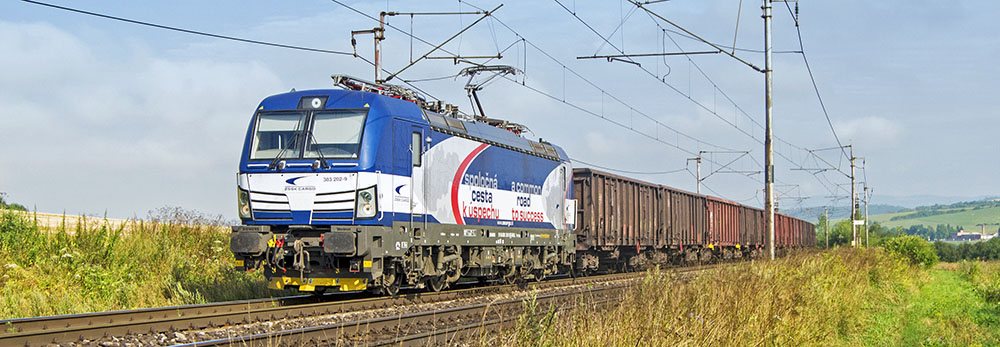Prihláste sa na odber noviniek


Most of us associate sand with the summer holiday at the beach. For ZSSK CARGO it is one of the commodities belong to the timber and building materials group. Yet, some of the sand transports are not aiming at the construction industry, but for daily use by every one of us. That is because they are the basic raw materials for packaging glass production.
Bor lowland, situated in the western Záhorie region in Slovakia, is very specific by its geological subsoil. Apart from rare oil deposits, you can mainly find sands here. Although aeolian sands as a subsoil are very rare to Slovakia, representing around 1% of all land, they dominate in the Bor lowland. The quality of these sands is highly-priced. Not just by the construction and chemical industry, but mainly by the glass producers.
Rich Deposits of High-Quality Sand Near the Town of Senica
The mining deposit of company Kerkosand in Šajdíkove Humence lies only around 80 km northwest of the capital city of Bratislava. Sand has been mined here for over 40 years. Its use in the glass manufacturing industry helps the increased use of ecological packaging. And ecological transport is a necessary part of ecological production.
Return of Railways to Sand Transports
Back in 2003, citizens of Šajdíkove Humence complained about the passage of up to 35 trucks loaded with heavy sand a day. Passing the narrow streets of the village, they have caused dustiness, noise, and vibrations. Such is the result when seemingly unnoticed transports move from rail to road. This can be the case of seven million tons of goods, such as timber and scrap, loaded to individual wagonloads all across Slovakia. ZSSK CARGO is, within the corporate social responsibility, keeping this nonprofitable business as the only company in Slovakia. But, without state aid, this is not a sustainable model. In Šajdíkove Humence, citizens can speak about the discomfort caused by trucks. But, here, the transports of sands have returned to rails, at least the ones for the glass industry.
Sand Transports by Rail in Slovakia
Every two weeks ZSSK CARGO realizes the transportation of glass sands from Záhorie to the glass packaging manufacturer, company Vetropack in Nemšová. As special wagons are needed for transportation of this commodity, ZSSK CARGO cooperates with Czech colleagues from ČD Cargo, who own such types of wagons. In the morning hours, wagons are delivered from Czechia and they are immediately shunted for loading at the Kerkosand siding. On the same day, in the afternoon, they are fully loaded and ready for shipment.
150 Kilometer Transport that Saves the Roads
Šajdíkove Humence is situated on a single-track electrified railway line leading from Kúty to Trnava, passing the mountain range of Malé Karpaty. That is the reason why the track got nicknamed “the hump”. Electric locomotives of ZSSK CARGO lead the unit train of 18 - 20 wagons from the very beginning. For the 150-kilometre journey, locomotives class 363 or 240 are used. During the very last transport, even the newest rolling stock in the ZSSK CARGO fleet took the job – one of Vectron locomotives, class 383. After passing “the hump”, the train connects to the main modernized railway track in Slovakia in the town of Trnava. Its destination is the station of Trenčianska Teplá. Here, the electric locomotives are replaced by diesel ones, class 742 or 736 to move the freight for the last 4 kilometres of unelectrified track to the station of Nemšová, shunting them to the Vetropack siding for unloading.
Bulk Sand into a Solid Glass
Apart from silica sands, the manufacturer needs lime, soda, dolomite, and feldspar to turn, using the temperature of 1,600ºC the bulk materials into a resistant packaging glass. Making glass demands less energy consumption than for example by aluminium production. Once the glass is made, it can be practically endlessly recycled. Drinks producers, as well as a common household, using jam jars, cannot imagine functioning without glass packaging.
Further Transports into Europe
The glass sand deposit in Šajdíkové Humence and the services of ZSSK CARGO in its transport are also used by another glass manufacturer, but this time from Slovenia. For a long time, Slovenian wagons are used for this, in a unit train of 21 wagons. Three to five times a month a train heads the opposite way via “the hump” to the station of Kúty, where wagons are handed over to the partnering carrier – ČD Cargo.
Single Wagonloads and the Potential of Recycled Waste Transport
Not only unit trains are heading to the customers. Single wagons and groups of wagons are heading from Šajdíkove Humence to the station of Olomouc too. On the other side, ZSSK CARGO offers the transportation of final goods from Vetropack in Nemšová. Covered freight cars transport glass packaging to the foodstuff producers, who need the packaging for the smooth dispatch of their products. ZSSK CARGO is very much interested in offering more options for such transports, as this is the railway ideal transport between two stable points of demand and supply.
There is an untouched potential - being the transport of recycled glass. Recycled waste logistics, similarly to iron scrap, will play an ever-increasing role in the transformation of economies into green ones.
Sand for the Trains
An inseparable part of the sand transports is the deliveries for ZSSK CARGO itself, as well as deliveries for the national passenger rail carrier, ZSSK. Soft sand is a part of every locomotive and train on rails. The place, where steel wheel meets steel rail becomes slipper during the rain, especially in the autumn. Sand is spread under every wheel and that increases traction and eliminates wheel slip of trains on rails.
Photo: Peter Nikmon